Ireland's tree-planting policies are bad news for biodiversity
Analysis reveals licences for conifer plantations still being granted on biodiversity-rich areas and precious peat soils.

PICKLING AWAY IN the acids of our remaining peatlands are a minute array of pollen grains formed from the remains of various species of trees that once blanketed our island from coast to coast.
Ireland was once covered with forests comprising the likes of birch, oak and elm, species which emerged following the end of the Ice Age.
Historic deforestation over the centuries, however, transformed our island from a prehistoric primeval forest to one of the least forested countries in Europe and we are still playing catch-up.
Today, around 770,000 hectares (ha) or 11% of our landmass is covered in trees, compared to the EU average of over 30%. We are out in front in one area though.
We have one of the highest rates of plantation forestry in the EU and the highest share of forest area dominated by introduced tree species, with large plantations of mainly Sitka spruce - native to North America – making up just over half of our entire forest estate.
Following a State-led plan in the 1950s and 1960s to plant in what was then seen as marginal land, much of it was planted on the very same peatlands and biodiversity-rich areas where remnants of our ancient native mixed species forests have been discovered.
Today, there are various environmental requirements in place for greater biodiversity protection in forestry, including set back distances from water courses, the setting aside of 10-15% of afforestation sites for open spaces and retained habitats for biodiversity, and planting of broadleaves.
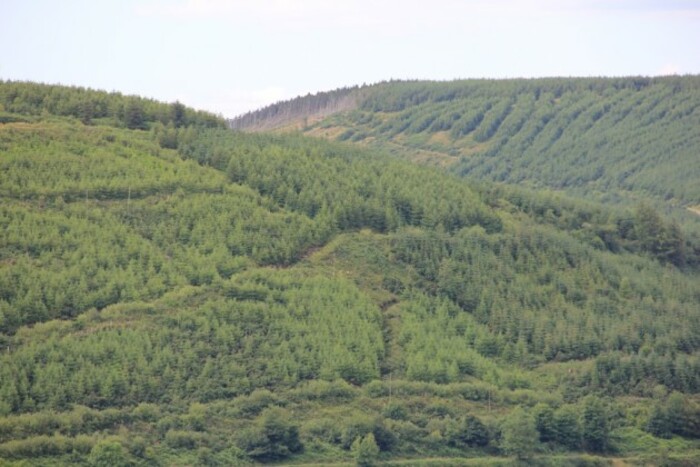 Conifer plantations in the Slievefelim to Silvermines SPA
Conifer plantations in the Slievefelim to Silvermines SPA
The plantation model, however, has still come under heavy criticism from conservation and community groups in areas with high planting rates. This form of forestry is lined up to play a critical role in State plans to hit a target of 18% land cover over the coming decades, with 70% of future planting set to be conifers.
Over the past three months, Noteworthy has examined the potential environmental impacts of our historic conifer-led forestry policy, speaking with biodiversity and nature experts and combing through hundreds of pages of research and scientific papers.
We also pieced together data on over 30,000 afforestation and felling licence applications, as well as hundreds of appeals cases brought against forestry licences released under Access to Information on the Environment (AIE) Regulations to examine the level of checks and balances that the Forest Service has in place to ensure that biodiversity is protected.
We can reveal:
- Only three environmental impact assessments have been carried out for over 17,000 afforestation licence applications received by the Forest Service since 2010.
- An analysis of almost 170 decisions made on appeals against forestry licences in 2020 reveals that, in several cases, biodiversity assessments were found to be unsatisfactory.
- Licences for plantations continue to be approved on or near peat soils and other high nature value areas.
- Ireland’s leading freshwater pearl mussel experts are heavily critical of draft plans to mitigate the impact of plantations in areas vital to the survival of the endangered species.
- Government data sent to the European Commission last year shows that managed forestry may be releasing more carbon than it takes in, partly due to drainage and planting on sensitive soils.
- Concerns remain over management of forestry operations in protected areas – for example, there have been longs delays in setting proper guidelines to protect the at-risk hen harrier.
A planting legacy
The latest data from the Forest Service – which sits under the Department of Agriculture (DAFM) – shows that Ireland’s forest estate is 71.2% conifers and 28.7% broadleaves.
The data highlights the dominance of conifer plantations where plots of trees of the same age are planted, thinned, and generally clearfelled after 30 or 40 years and then replanted.
According to the National Parks and Wildlife Service (NPWS), this form of forestry is one of the biggest pressures on EU protected habitats such as peatlands, biodiversity-rich semi-natural grasslands, and wetlands and the species that depend on them.
One of the key reasons for this is that many of Ireland’s older forestry plantations are located in biodiversity-rich upland areas and peatland following a State-led planting drive from the 1950s. This is reflected in the fact that Coillte is one of the largest owners of peatland habitat, with 232,500ha of its estate in peatlands in 2015.
Unique in the world
While very little of Irish peatlands are today free from human impact, what is left, according to UCD peatland expert Florence Renou-Wilson, is “really unique in the world” and acts as Ireland’s most important carbon store.
Another thing that makes them particularly unique, she said, is that, unlike bog found in Canada or Scandinavia, conifers do not naturally grow on Irish peat and require drainage prior to planting.
According to Renou-Wilson, cutting introduces oxygen in the peat which has never seen oxygen before and immediately starts to decompose, “releasing molecules of carbon back to the atmosphere, continuously, there’s no stopping it. The only way to stop that again is for it to be wet”.
The national forest estate is an important carbon reservoir – 311 million tonnes of carbon in 2017 – with 79% of the carbon in the forest soils. Renou-Wilson said, however, that while you have “something very good here in trees that capture carbon”, at the same time “you are still losing that carbon from the peat”.
“The problem with trees though is as soon as they’re big enough, they’re going to be cut again. So we’re back to square one. So it’s a real battle to balance.”
According to the National Forestry Accounting Plan for 2021 to 2025, managed forest land is already a net carbon emitter with a transition from a sink to a source by 2017. The report projected “consistent increases” in emissions from 2018 to 2025, partly due to an increase in harvesting and emissions released from organic soils due to drainage.
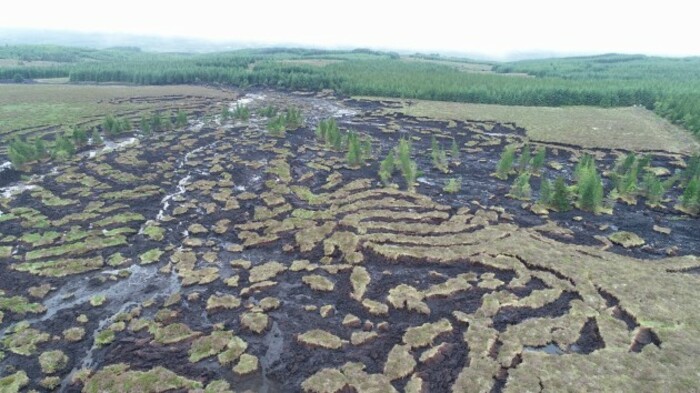 Shass landslide, June 2020
Shass landslide, June 2020
Landslide impacts
Another issue, according to TCD Professor Paul Johnston, an environmental engineer who specialises in hydrology, is the role that drainage can play in subsidence events due to the cutting into peat.
There was a major landslide on the heavily-planted Shass Mountain in Co Leitrim in June 2020 after heavy rain preceded by a dry period, resulting in a large quantity of liquefied peat and trees flowing down the mountain, impacting Lough Allen, farmland, properties, roads, and forestry operations.
While it is unknown yet if forestry had a direct role in causing the landslide, Johnston said that “there is a role that forestry can and does play in the failure of blanket bog, bog slides and bog flows” due to drainage, as well as the increasing weight of the trees that represent an increasing load as they grow.
An Interagency Response Group has been established, according to the Department of Housing, and RPS Group Consulting Engineers has been appointed to prepare a report about the landslide to be reviewed by a technical steering group.
“The report is an account of the state of the environment and makes recommendations for management options. However, the report has not identified the main cause of the peat failure,” the Department said. This was confirmed by Leitrim County Council.
Water quality impact
Drainage is also often vertically down the hill or slope, exacerbating runoff, with various scientific papers indicating that planting and felling on upland peat poses a significant threat to water quality.
Forestry is the main pressure on high status water bodies, noted by the EPA as a significant pressure in 51 of the 127 at-risk water bodies with a high ecological status.
According to An Taisce’s Elaine McGoff, a freshwater ecology specialist, our pristine water sites close to forestry are “just nosediving”, especially those in upland areas with peat.
“Upland rivers need to be very clean [with] no silt. Then you plant these trees and the draining can lead to siltation and the clearfelling can lead to really serious siltation,” she said.
HYDROFOR, a seven-year study carried out by scientists at several universities and co-funded by the EPA and DAFM that concluded in 2016, investigated the relationship between conifer forests and ecology in Irish rivers and lakes, recommending the cessation of planting on peat soils in acid-sensitive headwater catchments.
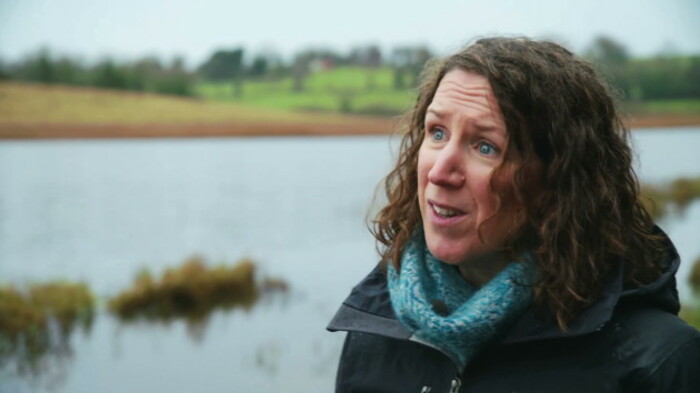 Elaine McGoff, An Taisce
Elaine McGoff, An Taisce
The HYDROFOR project was also advised by the NPWS, Inland Fisheries Ireland, the Marine Institute and Coillte which told Noteworthy that it has proactively worked with the Forest Service over the past three decades to ensure guidelines include the “most appropriate forest mitigations to be adopted on forest operation sites, including the introduction of mandatory setbacks from identified watercourses”.
“The company works closely with its forest contractors to ensure that they are fully aware of when and where mitigation measures are to be adopted on site, including the installation of silt traps to counter the risk of silt run-off,” it said.
Freshwater pearl mussel
One species impacted by forestry activity is the endangered freshwater pearl mussel (FPM) as it needs really clean water to survive.
Forestry on upland peatlands is a key pressure across the 27 catchments where the keystone species is found. In 2018, the Forest Service put together a draft plan to mitigate the impact of forestry on the species.
The plan, however, was heavily criticised and labelled as “flawed” by Ireland’s three leading FPM experts.
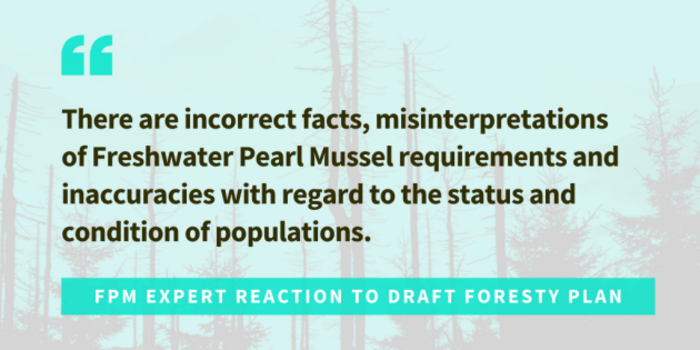
They said that clearfelling and afforestation are inappropriate for the main eight catchments that contain 80% of the species populations, and that “the emphasis should be on restoration of open peat habitats, where the legacy forestry has been on peat”.
“For the sake of the species for which the plan is written,” they said, it should be “abandoned and rewritten again with the aim of protection of the species’ requirements in mind”.
The NPWS also outlined its concern, stating that the conclusion that the Draft Plan will not adversely affect protected sites is “not warranted”. A final version of the plan has not been released to date.
The Department of Agriculture told Noteworthy that feedback to the comments received have been prepared, with “recent and ongoing refinements to the DAFM’s appropriate assessment procedure now overtaking many of the measures proposed”.
It added, however, that it does not see “widespread forest removal and a return to pre-development habitat, as purported by experts, as realistic propositions”.
“Instead, the Department sees the types of solutions arrived at under KerryLIFE (to which it was a co-beneficiary), arrived at throughout the robust application of appropriate assessment, as pointing the forward way.”
Coillte told Noteworthy that it does not apply for any new afforestation licences on peatlands and has “restored over 3,000 hectares of Irish rare peatland habitats”, as well as working with independent ecologists to identify over 90,000 hectares to be managed for biodiversity enhancement and habitat protection across its estate.
It said that it has also recently launched its Nature’s Wild Atlantic Bog Woodland Project that will see 2,100ha of Atlantic blanket bog currently planted with spruce and pine forests restored with rewetted bog and replanted with native woodlands where it is environmentally appropriate.
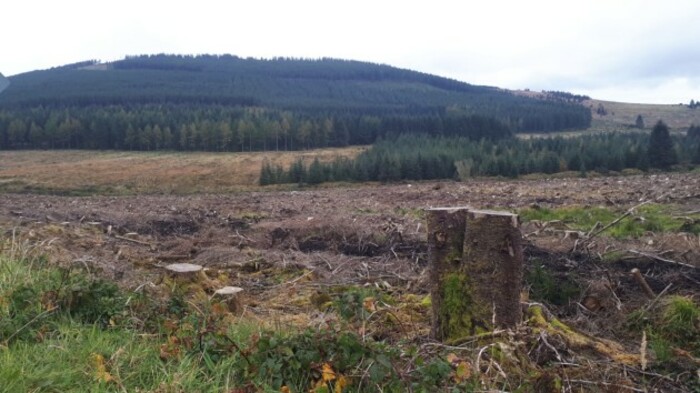 Plantation site after clearfell in the Wicklow Mountains
Plantation site after clearfell in the Wicklow Mountains
Planting still occurring in peatlands
The impact of planting on peatlands is now widely recognised by the sector and the current Forestry Programme states that the “inappropriate afforestation” of peatlands is to be avoided.
An analysis of forestry licence appeal cases decided in 2020, however, shows that licences were recently granted for planting or felling in areas with peatlands or close to these sensitive areas.
In a ruling in July to cancel a felling licence for 3ha in Finnaun, Co Galway, it was found that the “proposal appears to be within an area classified as acid sensitive” and that the underlying soil is blanket peat.
In 2019, the Forest Service granted permission for an 11ha afforestation project in Doogary, Co Mayo on wetland and peat soils with a direct hydrological connection to the nearby River Moy SAC that contains raised bog.
The Forest Appeals Committee (FAC) overturned the decision as it was not satisfied that the proposed afforestation would not have a significant effect on protected sites in the Natura 2000 network.
In July, the FAC also overturned the decision to grant a licence for 15ha of afforestation in Meeltran, Co Mayo on a site that contains mineral peat within 850 meters of the River Moy SAC.
In May, it also cancelled a 10.5ha afforestation licence on mineral peat soil with heather vegetation suitable for hen harrier in Rathoran, Kerry and overturned an afforestation licence for almost 4ha in Culleenanory, Co Roscommon granted in August 2019 in an area close to cutaway bog.
The Department of Agriculture told Noteworthy that it cannot comment on any of the individual examples cited but that policy regarding eligible afforestation sites is clearly set out in its Land Types for Afforestation document.
The Department said that planting on suitable upland grassland or purple moor-grass with an average peat depth of less than 50 cm is allowed in certain circumstances and is limited to 20% of the overall area proposed for planting.
This, combined with other procedures in the document, “ensures that afforestation is taking place on land suitable for planting”, it said.
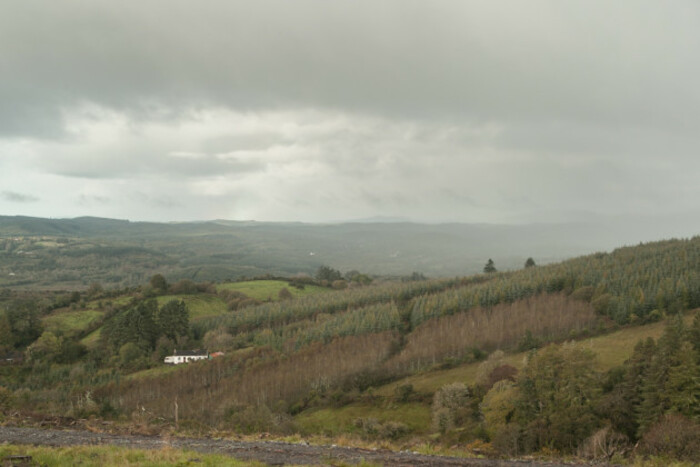 Plantation in uplands near Drumkeerin, Co Leitrim
Plantation in uplands near Drumkeerin, Co Leitrim
High nature value farmland
The Forestry Programme also states that inappropriate afforestation should be avoided in areas of ecological importance under high nature value farmland (HNVf).
Alongside historic planting in peatlands, areas traditionally thought of as marginal agricultural land, often on steep slopes with poorly drained soils in the uplands of counties such as Wicklow, Donegal, and Leitrim, were also heavily planted over the past decades.
According to Dr James Moran, a GMIT ecologist who specialises in HNVf, these areas are now “internationally renowned” for their biodiversity value, “supporting some of the rarest species and habitats in Western Europe associated with this extensive farming landscapes”.
Research by Irish scientists released this year shows that recent afforestation has “overlapped” with areas that have high numbers of birds of conservation concern. This work builds on a 2015 paper that found “plantation forests may already be having a negative impact” for threatened species dependent on grassland for foraging.
In a statement, DAFM said that any approval for an afforestation licence is reached following its Land Types for Afforestation procedure that includes referral to prescribed bodies and environmental assessment.
All afforestation, it added, must adhere to the Environmental Requirements for Afforestation and that it is “satisfied that these and other measures ensure that afforestation is in line with the current Forestry Programme”.
There is also grant aid for a wide range of other forest types including agro-forestry and native woodland establishment, it said.
Biodiversity-rich sites in the North-West
In 2016, the NPWS did raise concern to the Forest Service that it was “not clear how high nature value farming or associated farmland is being defined or considered” in environmental requirements for forestry.
This is “particularly relevant” to areas such as Leitrim and Cavan, it said, where there are fewer protected nature sites but “extensive areas of high-nature value farmland”.
Noteworthy has seen several NPWS observations on forest licence applications released via AIE that point to the high biodiversity value of proposed plantations in both counties.
In one NPWS report from January 2019 related to an afforestation application in Cashelbane, Co Cavan, concern was raised that several proposed plots contained “species rich acidic grasslands mosaics of high intrinsic nature/environmental, heritage and cultural value and importance”.
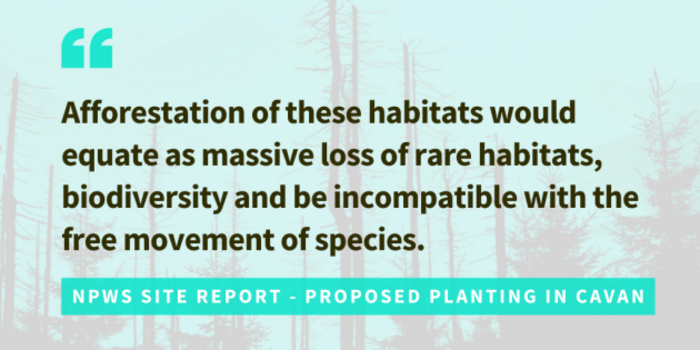
Pre-approval was withdrawn in this case, as it was for another proposed afforestation plot in the county in Edenmore after an NPWS report noted that the site was on upland peat soils with “a mosaic of heaths” of high nature value. This is prime foraging grounds for hen harrier and red listed meadow pipit, snipe and skylark, the report said.
Not all applications have been refused, however, according to a recent analysis by Neil Foulkes, a hedge layer who has put in over 200 appeals on forestry licences. He analysed semi-natural grassland survey data and the Forest Service’s planting records since 2014.
The analysis, he said, revealed that a little over 300ha of recorded semi-natural grassland was afforested between 2014 and 2019 at 65 sites in counties Cavan, Cork, Waterford, Mayo, Sligo and Leitrim.
Foulkes’ analysis included a 17ha plantation, approved in 2019 and planted in 2020, near Keshcarrigan in Co Leitrim that contains marsh and wet grassland habitats. An appeal was made to the Forestry Appeals Committee (FAC) by locals.
The FAC concluded that the proposal is “consistent with Government policy and good forestry practice and would not be detrimental to the amenities of the area”. It agreed that the licence should stand but with conditions for setback distances for a watercourse and hedgerow, as well as exclusion zones around ringforts on the site.
Another site at Manragh Upper, Co Cavan was approved in 2018 even though it ranked joint 11th nationally for its conservation score. An appeal was brought by locals and the decision was upheld. A High Court challenge was subsequently taken by one of the appellants.
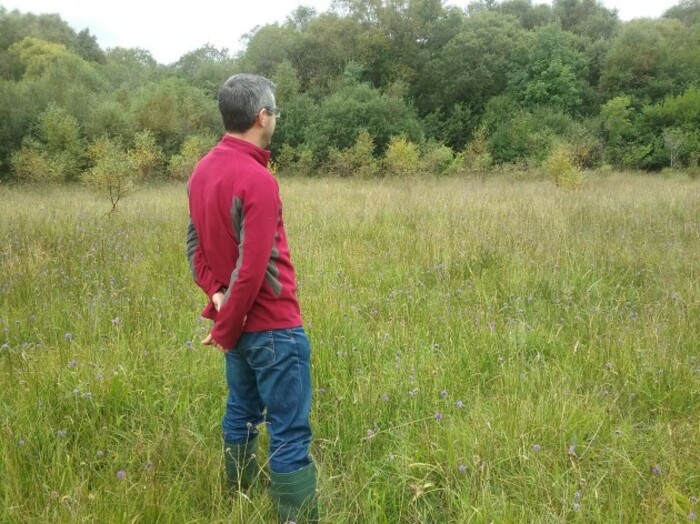 Ecologist Dr James Moran on HNVf site visit
Ecologist Dr James Moran on HNVf site visit
Possible solution to the problem
According to GMIT’s Moran, there needs to be better incentives for farmers to protect these biodiversity-rich areas as EU subsidy payments for their land pale in comparison to what can be earned from the tax-free returns from forestry.
“This is a big fault of the policy at the moment – try and struggle with farming and the subsidy system not recognising the value of it or plant it and have enough income that allows you to afford to farm.”
Moran said that some progress is being made with results-based payment schemes for on-farm ecosystem services. He is currently working on a research project on this topic with Ryan Wilson-Parr of the Irish Raptor Study Group who is involved with the Hen Harrier Project with 1,500 farmers.
Wilson-Parr, an upland ecologist, is particularly concerned with the impact of forestry on the species that he said has “continued to decline and crash” in areas for its protection that were heavily forested prior to designation as Natura 2000 sites.
 Hen harrier in flight
Hen harrier in flight
A species in rapid decline
Lack of adequate protection for the ground nesting species played a part in a 2007 European judgement against Ireland for a failure to meet environmental obligations under EU law, and six Special Protection Areas (SPA) were subsequently drawn up.
It is estimated that there can only be a maximum of 40% forest cover in the protected areas to protect the species, however, the average forest cover currently exceeds 50%.
Although hen harriers will use young conifer plantations for nesting and foraging, once the forest matures and the canopy closes, around a decade in, this habitat becomes largely unsuitable.
It was predicted in 2006 that afforestation and the maturing age of current plantations would drive the loss of open habitat for the species beyond critical levels by 2015, with a survey that year estimating a remaining breeding population of just 108 to 157 pairs.
The Forest Service suspended approval of afforestation licences in the SPAs in 2013 pending the development of a Threat Response Plan for the conservation of the species led by the NPWS that was set to be completed by mid-2015.
‘Vortex of inaction’
Things have moved very slowly, however, according to Wilson-Parr, who sat on a consultative committee of stakeholders from the Forest Service, Coillte, and other interest groups from forestry, agriculture, wind energy, and conservation groups.
From committee minutes and submissions released to Noteworthy, there was a clear divide between forestry and farming sectors pushing to allow more planting, and conservation and raptor specialists who wanted a full ban based, according to Wilson-Parr, on two decades of scientific research.
“It seemed like we were constantly in this vortex of discussing issues despite having all the evidence to hand. It’s very frustrating,” Wilson-Parr said.
In a joint submission, the Irish Farmers’ Association (IFA), Coillte and timber and forestry associations called for the ban “to be lifted at the earliest opportunity”.
They said that the SPAs were “not delivering protection” as breeding pairs within them were declining. “With a stable population nationally the reality appears to be that the bird has simply selected alternative areas to breed.”
In its submission, the Forest Service said that there is scope for afforestation within the SPA network and that reducing forestry to 40% would see 24,000ha clearfelled with potential revenue losses of €126m and carbon emissions of 8 million tonnes without replanting.
Farming and forestry groups also suggested that there is a positive correlation between forestry levels and breeding pairs as the hen harrier stronghold of the Slieve Bloom Mountains is nearly 60% conifer plantation and has experienced the largest population increase since 2005.
According to Wilson-Parr, who is the Slieve Bloom project officer in the Hen Harrier project, this idea is “completely misconceived” as the remaining 40% of the SPA is heather moorland, the species’ natural nesting habitat. It is estimated that 90% of hen harrier nests in the Slieve Bloom are in heather rather than afforested areas.
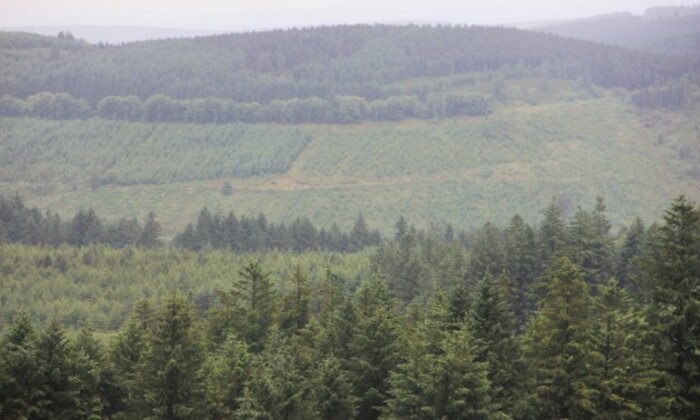 Conifer plantations in the Slieve Blooms SPA
Conifer plantations in the Slieve Blooms SPA
Draft disappointment
A draft of the plan was produced in 2016 and the draft minutes of the final committee meeting from May 2018 noted that both Wilson-Parr and Birdwatch Ireland were concerned the draft contained a “lack of clear targets, site-specific conservation objectives and detailed timelines”.
An updated version of the plan from the end of July 2020 was released to Noteworthy following an AIE request.
The latest draft does appear to have adopted a somewhat more cautious approach, with the Forest Service proposing a range of measures to make plantations more supportive of hen harrier conservation, including more open space and avoidance of disturbance to breeding and roosting.
Under the draft plan, the Forest Service and Coillte would be tasked with targeted forest removal on low productivity plots beside open moorland to expand and link hen harrier habitat. It is also proposed that the Forest Service “will not impose a replanting obligation on these forests”.
On viewing the draft, Wilson-Parr said that he found the majority of the proposed actions to still be “very vague” and that ultimately “forestry has to be removed” for the species to survive.
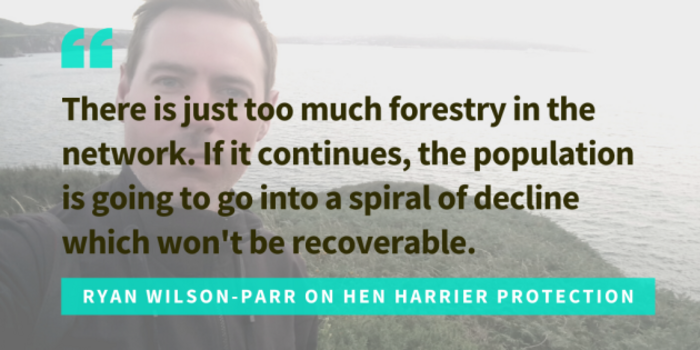
Environmental assessment in protected areas
Concerns that environmental assessments are not being carried out in line with strict EU environmental law has also been raised in various appeals to the FAC.
As part of the licensing process, all proposed forestry operations – felling, thinning, clearfelling and forest road construction – must be screened for their potential impact on any of the 430 protected nature sites across Ireland that fall within 15 kilometers of the proposed forestry site.
If this screening cannot rule out any potential significant impacts, then a more detailed and strict Appropriate Assessment (AA) must be carried out. If it is not capable of dispelling all reasonable scientific doubt as to the effects of the proposed works on the protected sites, then the licence should not be granted.
In late 2019, the Forest Service updated its AA procedure largely in response to decisions by the FAC to overturn several licences due to concerns about the screening process. The Department of Agriculture has said that a more stringent screening process is now in place with more cases requiring full assessment.
Noteworthy requested records for full Appropriate Assessments carried out for afforestation and felling licences since 2010 but was refused by DAFM as the request was deemed to be “manifestly unreasonable having regard to the volume or range of information sought”.
It did provide details on screening assessments since November 2019 after it brought in the new procedures. It said that each individual application would have a record on file but that it “cannot report or give an estimate on this” for such a volume of requested applications.
Neil Foulkes also made an AIE request to DAFM this summer for assessments for 10 specific afforestation licences wholly or partially in protected sites in Co Leitrim between 1995 and 2019. He was told that no records existed or could be found for any of the cases.
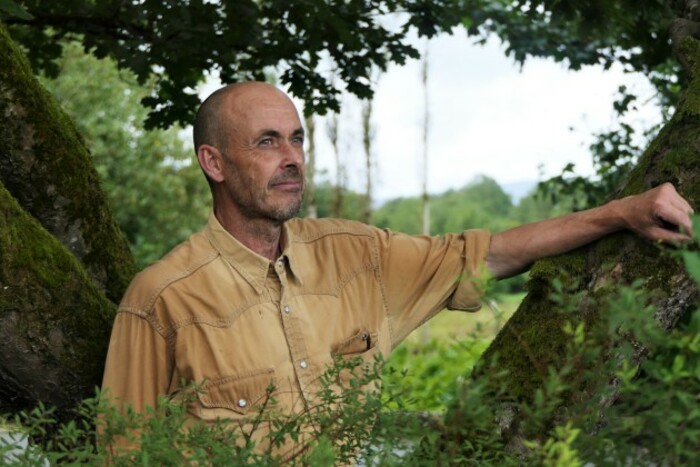 Neil Foulkes
Neil Foulkes
‘Absolutely and categorically wrong’
An Taisce’s Elaine McGoff also raised concerns that the Forest Service is not adequately assessing the potential cumulative impact of the proposed forestry site in combination with other forestry operations or projects in the area such as wind farms.
In a presentation to the Appropriate Assessment Forum in October 2019 released to Noteworthy, the Forest Service outlined its process to determine any potential in-combination impacts.
The presentation stated that, if the Forest Service determines that the project by itself will not have an impact on any protected sites, then there can be no potential impact in-combination with other projects.
An example in the presentation expands on this point: “Individually, the project does not represent a source, or if so, no pathway for significant effect on any European site exists. Consequently, there is no potential for the project to contribute to any such effects, when considered in combination with other plans and projects.”
We asked McGoff, who handles hundreds of forestry licences applications received by An Taisce – a statutory consultee in the forestry licensing consent system - to review the presentation. She found the Forest Service’s interpretation to be, in her view, “absolutely and categorically wrong”.
She said that “people are being hauled over the coals left, right and centre” for failure to correctly interpret EU law to protect habitats and species “on much smaller details” and that this “is a glaring legal case just waiting to be taken”.
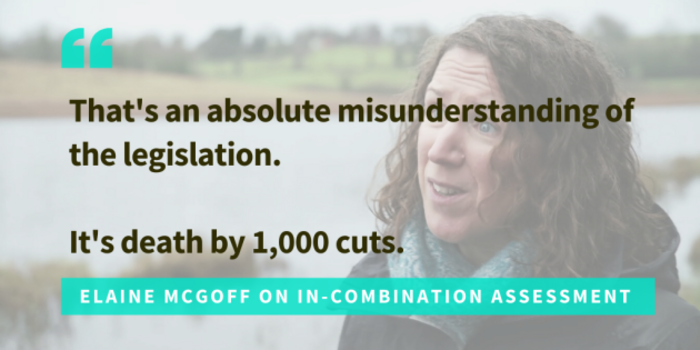
This issue was specifically highlighted by McGoff in an appeal taken by An Taisce last month, seen by Noteworthy, concerning an afforestation licence granted for 2.45ha beside the Slieve Bloom SPAs.
While the proposed site itself is small, the area already has 42% forest cover and the Forest Service’s screening identified “various forestry-related projects” in the vicinity, including felling licences totalling an area of over 350ha.
Yet, in carrying out an in-combination assessment as part of the screening process, the Forest Service found there were no potential significant in-combination impacts, a decision that An Taisce claimed in its appeal letter is “flawed”.
It argued that the Forest Service has “misdirected itself in the legal interpretation of the requirements of an in-combination assessment”.
“While one application alone may have no adverse impact on the integrity of a Natura site, a proliferation of afforestation within a certain radius could easily prove ecologically problematic,” An Taisce’s submission stated. The case is likely to be heard before the FAC later this year.
We’ve created a searchable table showing a detailed breakdown of appeal cases against forestry licence decisions. View this table here >>
Noteworthy has also seen a similar decision in another case set to go before the FAC concerning a felling application for over 21ha in Annaghaberg, Co Leitrim within 15km of Cuilcagh – Anierin Uplands SAC that contains important blanket bog, heaths and grasslands.
In this case, the Forest Service’s assessment showed that there are close to 20 plots of over 80ha planted nearby between 2015 and 2017, as well as over 30 approved felling licences covering an area in excess of 500ha.
The Forest Service determined, however, that “as there is no likelihood of the project itself (i.e. individually) having a significant effect on this European site, there is no potential for it to contribute to any cumulative adverse effects on the site, when considered in-combination with other plans”.
In a statement, the Department of Agriculture said that the in-combination assessment methodology and process is further detailed in its latest Appropriate Assessment Procedure: Standard Operating Procedure (SOP) document for forestry inspectors. This, it said, “provides a fuller account of the approach regarding in-combination assessment utilised by the DAFM at screening”.
The SOP document states: “The position adopted by the DAFM in this SOP is that, as the project itself (i.e. ‘individually’) cannot give rise to any impact, it cannot contribute to any impacts arising from any other plan or project. However, this position must be accompanied by a general overview of plans and projects in the vicinity.”
“In developing the approach, the Department has drawn from various sources and is satisfied that it is compliant [with NPWS guidance and EU Directives and EU case law],” the Department of Agriculture added in its statement to Noteworthy.
In a statement, the Department of Tourism, Culture, Arts, Gaeltacht, Sport and Media – under which the NPWS sat until recently – told Noteworthy that the service has “not reviewed these procedures in detail” and cannot determine if they are in line with EU law.
Concern raised over EIA assessments
Several experts and environmental groups who spoke to Noteworthy have also raised concerns that the vast majority of afforestation sites are also screened out from the need for an Environmental Impact Assessment (EIA). Thinning activities and applications for clearfelling and replanting are not subject to EIA.
This is not a new issue; a comprehensive judgement was delivered against Ireland by the European Court of Justice in 2007 for a failure to provide adequate protected sites for at-risk species, and it pointed to an inadequate EIA screening process in Ireland.
The EIA process ensures that projects that may have a significant effect on the environment are assessed in advance of its approval. While the Appropriate Assessment process only applies to Natura 2000 sites, EIA covers any location in the country.
One reason that licences are screened out for EIA, according to several experts who spoke to Noteworthy, is the 50ha threshold for a mandatory EIA assessment even though the average size of afforestation applications in 2019 was 8ha.
When submitting an application for an afforestation licence for an area above 50ha, the applicant must submit an Environmental Impact Assessment Report (EIAR) that analyses the likely effects of a proposed development on the environment.
An analysis carried out by Noteworthy on afforestation data shows that there were three applications since 2010 above the 50ha threshold. An EIA was not carried out for the three applications, however, in all three cases planting was not carried out.
According to DAFM, two of the applications were “not proceeded with by the applicants” and in the third case, technical approval was received but for a smaller site of 8ha.
“It was not planted in the end and the applicant did not move beyond technical approval,” it added in a statement to Noteworthy.
We’ve created a searchable table showing a detailed breakdown of afforestation licence applications and if AA screening and full EIA assessment was carried out based on data received from the Forest Service. View this table here >>
Several experts who spoke to Noteworthy stressed that assessments should be carried out for applications for smaller plantations as impacts can be felt at far lower than the 50ha threshold.
Under Irish regulations introduced in 2001, proposed plantation sites under 50ha must also be assessed where it is found that there may be a significant environmental impact from the project.
According to data released to Noteworthy, however, no EIAs were carried out on over 12,000 afforestation licences under 50ha granted by the Forest Service since 2010.
In 2015 alone, according to data released under AIE, almost 5,300ha were approved for planting on peat soils without a single EIA being carried out.
In addition, several large applications approved since 2010 ranging from 45 to 49.64ha were all screened out from the need for an EIA, according to an analysis of afforestation licence data.
The Department of Agriculture told Noteworthy that where a site is less than 50ha it carries out the sub-threshold screening for EIA in line with regulations.
“In many cases where there is an environmental issue, it can be resolved by other means e.g. Archaeology report, landscape report, Appropriate Assessment, ecology report, leading to additional specific conditions, reduced area or full refusal, without the requirement for an EIA,” it added.
In five technical licence approval letters for plantations of 49ha released to Noteworthy, the Forest Service outlines the need for the applicant to adhere to environmental and forestry guidelines, as well as specific conditions such as perimeter broadleaf planting and set-back distances from streams.
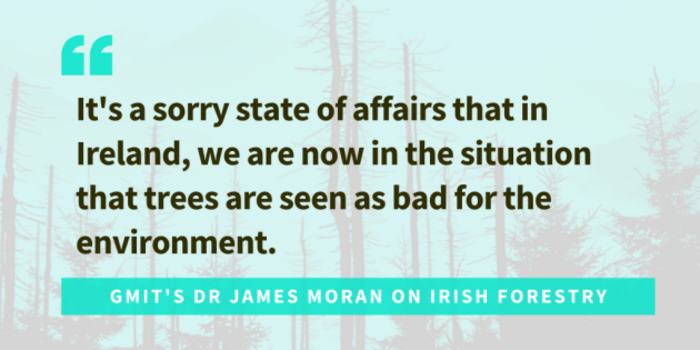
A brighter future ahead?
There can be positives with increasing tree cover in Ireland, with various experts who spoke to Noteworthy outlining how a turn toward native woodlands and an on-farm focus on agroforestry could improve the biodiversity value of Irish forestry.
The Programme for Government outlines plans to incentivise farmers to plant woodland on their farms and rewild up to one hectare of the farmland. It also outlines plans to invest in schemes to promote more recreational forestry, including expansion of the NeighbourWood Scheme.
The State also recently announced an ambitious Woodland Creation project to incentivise state agencies to plant native species on their lands, with documents released to Noteworthy indicating that several universities and county councils have shown interest, as well as Iárnróid Éireann, the ESB and Gas Networks Ireland.
The State aims to plant 300ha per year by 2024 under the project with a total cost of €15,000,000.
GMIT’s Moran said he hopes that a move toward greater biodiversity in our forestry model will lead to a better general opinion of forestry in Ireland.
“It’s a sorry state of affairs that in Ireland, we are now in the situation that trees are seen as bad for the environment. It’s an awful legacy that we’ve inherited from the previous generation and if we pass on that legacy to the next generation, we have done something seriously wrong.”
Tomorrow, we will examine the backlog in the forestry licensing and appeals process created by issues in how the Forest Service has assessed potential environmental impacts and speak to the three main appellants about why they are challenging forestry operations.

This investigation was carried out by Niall Sargent of Noteworthy. It was proposed and funded by you, our readers.
Noteworthy is the investigative journalism platform from TheJournal.ie. You can support our work by helping to fund one of our other investigation proposals or submitting an idea for a story. Click here to find out more >>
We also have a number of environmental investigation proposals which you can view here.








